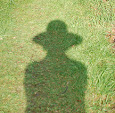Today is voting day for the Scottish independence referendum. As predicted lots of people turned out to mark their ballot paper: YES or NO to the one question "Should Scotland be an independent country?"
To mark the day both for ourselves and our grandchildren (who were off school) we decided to pay a visit to a place of historic significance in story of Scotland's drive for independence ... and that is Dumbarton Castle.
We took the children with us to vote and then headed off to the castle, a short half hour drive from our home.
It is situated on Dumbarton Rock, a volcanic plug, downriver from Glasgow, on the Clyde as it widens out to flow westwards into the Atlantic Ocean. It is a military garrison and not particularly inviting. Most people who live in and around it have never visited it and it is certainly not by any stretch of the imagination a popular tourist spot. It does however have a grim history.
We climbed to the trig point on the top. Here are Ishbel and I.
Iain pretended to blow the 2 mischief-makers out of the canon into Kingdom Come!
However we had a more serious reason for visiting the castle and that
was to mark the fact that another person in history, William Wallace,
otherwise known popularly from the film" Braveheart", has an association
with this castle.
Wallace Tower ruins undergoing restoration. The arrow points to the plaque.
William Wallace is a great hero of Scotland as he fought for Scotland against England in the wars for Scottish independence many hundreds of years ago (late 13th and 14th centuries). So why is he part of the history of Dumbarton Castle? The information on the display board (in an out of the way Guard's Room) say it all as shown below:
"William Wallace: captor and captive
When William Wallace defeated the English at Stirling Bridge in 1297, Dumbarton Castle was held by an English garrison, who fled within a few days. Wallace imprisoned his captives Marmaduke Tweng, William Fitzwarin and William de Ros here, holding the English knights for future exchange with Scottish nobles held by the English. Eight years later, Wallace himself was brought here after being betrayed to Menteith, Dumbarton’s governor, and it was from here that he was taken on horseback to London for bloody execution."
When William Wallace defeated the English at Stirling Bridge in 1297, Dumbarton Castle was held by an English garrison, who fled within a few days. Wallace imprisoned his captives Marmaduke Tweng, William Fitzwarin and William de Ros here, holding the English knights for future exchange with Scottish nobles held by the English. Eight years later, Wallace himself was brought here after being betrayed to Menteith, Dumbarton’s governor, and it was from here that he was taken on horseback to London for bloody execution."
His execution was particularly gruesome so that those supporters of his cause would be deterred from trying to push for independence ... until ... today .... all these hundreds of years later.
* * * * * * *
For more information on William Wallace see a previous post March 31, 2014 where I have photos of his statue in Aberdeen and also the full text of the plaque at it base. The link is here.









No comments:
Post a Comment